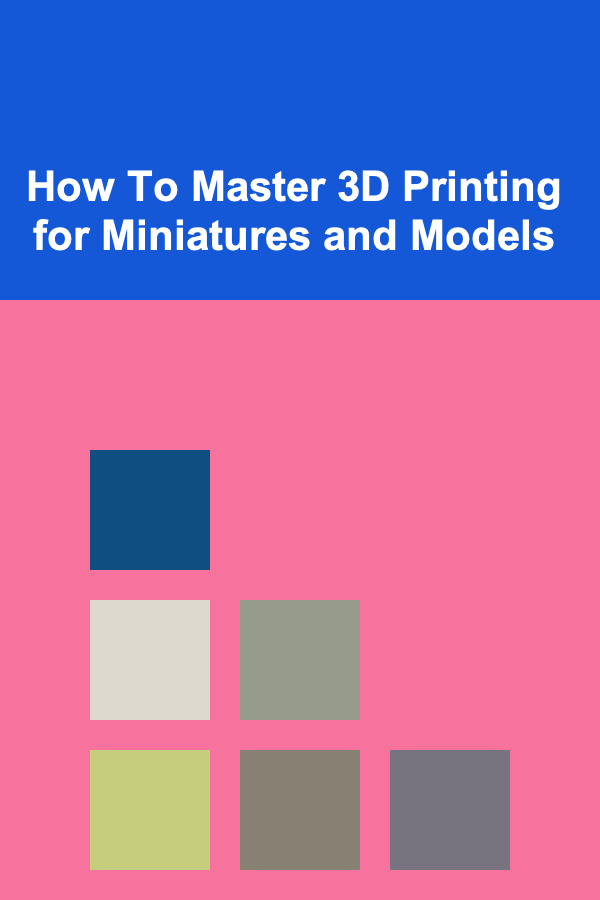
How To Master 3D Printing for Miniatures and Models
ebook include PDF & Audio bundle (Micro Guide)
$12.99$10.99
Limited Time Offer! Order within the next:

In recent years, 3D printing has revolutionized a multitude of industries, from healthcare to automotive to fashion. However, one of the most exciting and accessible applications of this technology is in the realm of miniatures and models. Whether you're a hobbyist, a tabletop gamer, or a professional designer, the ability to create intricate, detailed miniatures and models at home has become a game-changer. This article will guide you through the process of mastering 3D printing for miniatures and models, exploring everything from the basics of 3D printing to advanced techniques and troubleshooting.
Understanding 3D Printing
Before diving into the specifics of 3D printing for miniatures, it's essential to understand the core concept of the technology itself. At its most basic level, 3D printing is an additive manufacturing process where objects are created layer by layer from a digital model. Unlike traditional manufacturing methods that often involve subtracting material (like milling or carving), 3D printing builds up material to create the final object.
For miniatures and models, this process is particularly beneficial due to its precision and versatility. A range of 3D printing technologies and materials are available, each offering unique benefits depending on the requirements of the model.
Types of 3D Printing Technologies
- Fused Deposition Modeling (FDM): This is one of the most common and affordable 3D printing technologies. FDM works by extruding a filament (usually plastic) through a heated nozzle, layer by layer, to form the object. While FDM printers are great for basic models and prototypes, they may struggle with fine details and intricate designs that are often needed for miniatures.
- Stereolithography (SLA): SLA printing uses a liquid resin that is cured layer by layer using a UV laser. The advantage of SLA is its ability to create highly detailed models with smooth surfaces, making it the ideal choice for miniatures and highly detailed models. However, it tends to be more expensive than FDM, both in terms of initial setup and ongoing resin costs.
- Digital Light Processing (DLP): DLP is similar to SLA in that it uses a liquid resin and UV light to cure it, but DLP uses a digital light projector rather than a laser. DLP printers are typically faster than SLA printers, making them an appealing choice for creating multiple miniatures at once.
- Selective Laser Sintering (SLS): SLS uses a laser to sinter powdered materials (such as nylon), fusing them into solid layers. SLS is best suited for professional applications due to its high cost and ability to create strong, durable parts. However, the resolution isn't as fine as SLA or DLP, so it's less commonly used for miniatures.
Choosing the Right Printer for Miniatures
When selecting a 3D printer for miniatures and models, there are several key factors to consider:
- Resolution: The level of detail a printer can achieve is measured by its resolution, typically in microns (µm). The lower the micron number, the higher the resolution. For miniatures, you'll want a printer that can print with at least 50µm resolution, but ideally, you should aim for printers that can reach 25µm or even 10µm for exceptional detail.
- Material Compatibility: Different printers are compatible with different types of materials. FDM printers generally use plastic filaments like PLA, ABS, and PETG, while SLA and DLP printers use resin. It's important to choose a printer that supports materials that suit your needs, such as flexible resins for creating parts with movement or specialty filaments for specific textures.
- Print Size: Miniatures typically require smaller print beds, but if you plan to print larger models or multiple miniatures at once, you'll need a printer with a larger build volume. Be sure to check the maximum print dimensions of the printer and make sure they are adequate for your intended projects.
- Speed: While SLA and DLP printers generally offer more precision, they can also be slower than FDM printers, particularly for larger models. Speed may be a factor if you're working with large volumes of miniatures.
- Price: The price of 3D printers can range from a few hundred to several thousand dollars. While budget-friendly FDM printers are available, SLA and DLP printers are typically more expensive. Determine your budget and the features you need, and then research the best options within that price range.
Getting Started with 3D Printing for Miniatures
Once you've chosen your 3D printer, it's time to start creating miniatures and models. Here's a step-by-step guide to getting started:
Step 1: Choose or Create Your 3D Model
The first step in the 3D printing process is selecting or designing your miniature model. There are two primary routes you can take:
- Download Pre-made Models: There are numerous online repositories of free and paid 3D models specifically designed for 3D printing miniatures. Websites like Thingiverse, MyMiniFactory, and Cults3D offer a wide variety of miniatures ranging from tabletop game pieces to collectible models. Ensure that the models are designed with 3D printing in mind, as some may require adjustments to be printable.
- Design Your Own Models: If you have specific ideas or need custom miniatures, you can design your own models using 3D modeling software. Some popular programs for designing 3D models include Blender, Tinkercad, Fusion 360, and ZBrush. While some software is free and beginner-friendly (like Tinkercad), others like ZBrush are more advanced and better suited for creating highly detailed models.
When designing, ensure that the model is suited for 3D printing by paying attention to factors like wall thickness, support structures, and overhangs.
Step 2: Prepare Your Model for Printing
After you have your 3D model, the next step is to prepare it for printing. This involves converting the 3D model into a format that the 3D printer can read. Most 3D printers use the STL (stereolithography) file format, which contains the 3D geometry of the model.
To prepare your model for printing, you'll need to use slicing software, which takes your model and "slices" it into layers that the 3D printer can print. Popular slicing software includes Cura (for FDM printers), Chitubox (for SLA and DLP printers), and PrusaSlicer.
While slicing, you'll need to adjust a few key settings:
- Layer Height: Smaller layer heights (e.g., 0.1mm) lead to higher detail but longer print times. For miniatures, a layer height of 0.05mm or 0.1mm is ideal.
- Support Structures: Some models will require supports to print certain overhangs or intricate details. Most slicing software can automatically generate support structures, but you can also manually place them where needed.
- Infill Density: For miniatures, you don't need a high infill density. A 10-20% infill is usually sufficient for miniatures, balancing strength and material use.
Step 3: Printing the Model
Once your model is sliced, it's time to send it to the printer. Ensure that your 3D printer is properly calibrated before starting the print. This includes leveling the print bed, ensuring that the extruder is clean and functioning, and verifying that you have the right material loaded.
For FDM printers, start the print process and monitor the initial layers to ensure they adhere to the print bed properly. For SLA and DLP printers, make sure the resin vat is properly filled and that the UV light source is functioning correctly.
Step 4: Post-Processing
After the print is complete, the next step is post-processing. This involves removing supports, cleaning the model, and sometimes painting it.
- Removing Supports: If you printed the model with support structures, carefully remove them using pliers or cutters. You may need to file or sand any rough spots left by the supports.
- Cleaning: For SLA and DLP prints, you'll need to clean the model in isopropyl alcohol to remove excess resin. FDM prints may require less cleaning, but they may have visible layer lines that you'll want to smooth out.
- Sanding and Smoothing: Depending on the type of printer and material, you may need to sand your miniatures to achieve a smooth surface. Fine-grit sandpaper or a rotary tool can help achieve a professional finish.
- Painting: Once the model is clean and smooth, you can paint it to bring out the details. Miniatures are typically painted with acrylic paints, and many hobbyists use techniques like dry brushing, washes, and layering to achieve a realistic finish.
Step 5: Troubleshooting and Fine-Tuning
While 3D printing is a relatively straightforward process, there are occasional challenges that you may encounter:
- Poor Adhesion: If the model doesn't adhere to the print bed, it may warp or fail mid-print. Ensure that the bed is clean and level. For FDM printers, you can also use adhesion aids like glue sticks or painter's tape.
- Stringing: Stringing occurs when filament oozes from the nozzle during travel moves, leaving thin strings on the model. This can be mitigated by adjusting retraction settings in your slicer software.
- Layer Shifts: If the print has visible horizontal lines or the layers shift, it may indicate a mechanical issue with the printer, such as a loose belt or misaligned axis. Inspect the printer for issues and recalibrate if necessary.
Advanced Techniques for Miniatures
As you gain more experience with 3D printing, you may want to explore advanced techniques for enhancing your miniatures:
- Multi-Color Printing: Some printers allow for multi-color printing, either by using multiple extruders or by swapping filament during the print. This can be especially useful for miniatures that require intricate color detailing.
- Texturing and Detailing: Advanced 3D modeling software like ZBrush allows you to add detailed textures and fine details to your models, such as fabric patterns, wrinkles, and facial features.
- Resin Blending: For SLA printers, you can experiment with blending different types of resins to achieve unique properties, such as flexible parts or a glossy finish.
Conclusion
Mastering 3D printing for miniatures and models is an exciting and rewarding process that combines creativity, technology, and problem-solving. By understanding the different printing technologies, choosing the right printer, and honing your design and printing skills, you can produce detailed, high-quality miniatures for gaming, collecting, or professional projects. Whether you're a beginner or an experienced maker, there are always new techniques to learn and ways to improve your craft. With patience, practice, and persistence, you can take your miniature-making to the next level with the power of 3D printing.

How to Create a Cozy Holiday Reading Nook in Your Home
Read More
How To Master Competitive Downhill Mountain Biking
Read More
How to Date in Your 30s and Beyond
Read More
How to Build a Stronger Willpower
Read More
10 Tips for Printing Address Labels at Home Like a Pro
Read More
10 Tips for Planning a Destination Wedding Abroad
Read MoreOther Products

How to Create a Cozy Holiday Reading Nook in Your Home
Read More
How To Master Competitive Downhill Mountain Biking
Read More
How to Date in Your 30s and Beyond
Read More
How to Build a Stronger Willpower
Read More
10 Tips for Printing Address Labels at Home Like a Pro
Read More